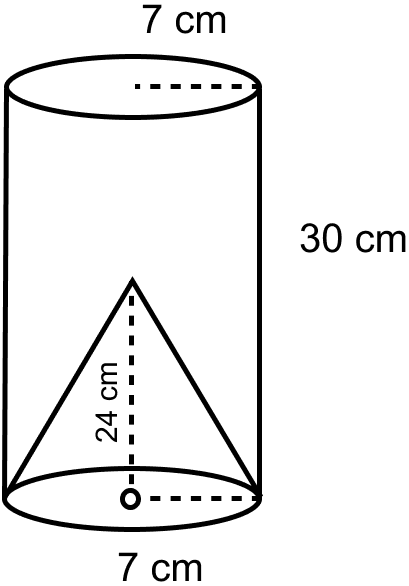Mathematics
From a solid cylinder of height 30 cm and radius 7 cm, a conical cavity of height 24 cm and of base radius 7 cm is drilled out. Find the volume and the total surface of the remaining solid.
Mensuration
73 Likes
Answer
The figure is shown below:

Radius of the solid cylinder = Radius of cone = r = 7 cm.
Height of the cylinder, H = 30 cm
Height of cone, h = 24 cm.
Slant height of cone, l = .
Putting values we get,
l = m.
Volume of the remaining solid (V) = Volume of the cylinder - Volume of the cone.
Total surface area of the remaining solid (S) = Curved surface area of cylinder + Area of base of cylinder + Curved surface area of cone.
Hence, the volume of the remaining solid = 3388 cm3 and surface area = 2024 cm2.
Answered By
47 Likes
Related Questions
A circus tent is in the shape of a cylinder surmounted by a cone. The diameter of the cylindrical portion is 24 m and its height is 11 m. If the vertex of the cone is 16 m above the ground, find the area of the canvas used to make the tent.
An exhibition tent is in the form of a cylinder surmounted by a cone. The height of the tent above the ground is 85 m and the height of the cylindrical part is 50 m. If the diameter of the base is 168 m, find the quantity of canvas required to make the tent. Allow 20% extra for folds and stitching. Give your answers to the nearest m2.
The adjoining figure shows a hemisphere of radius 5 cm surmounted by a right circular cone of base radius 5 cm. Find the volume of the solid if the height of the cone is 7 cm. Give your answer correct to two places of decimal.

A buoy is made in the form of a hemisphere surmounted by a right cone whose circular base coincides with the plane surface of the hemisphere. The radius of the base of the cone is 3.5 metres and its volume is of the hemisphere. Calculate the height of the cone and the surface area of the buoy correct to 2 places of decimal.